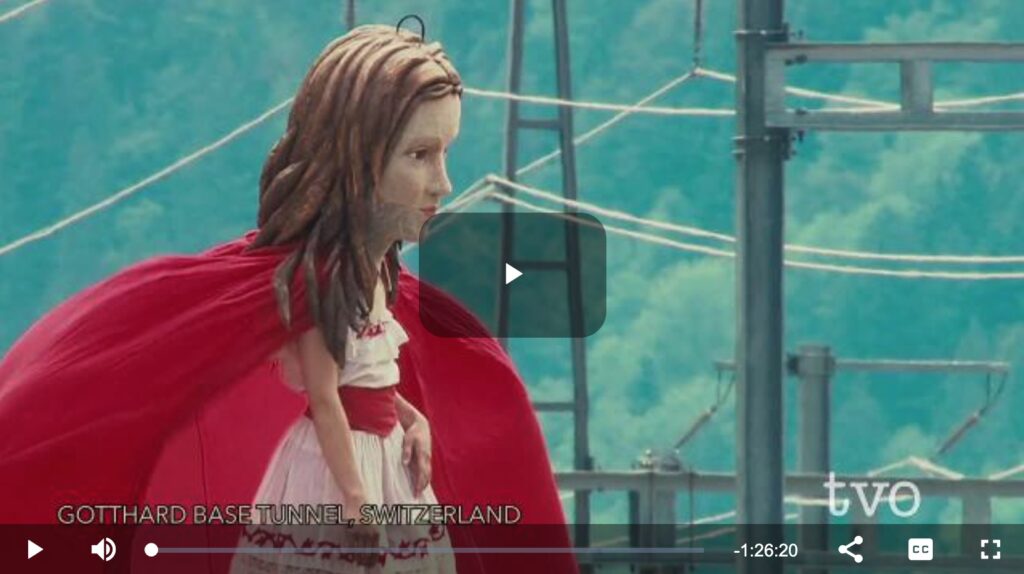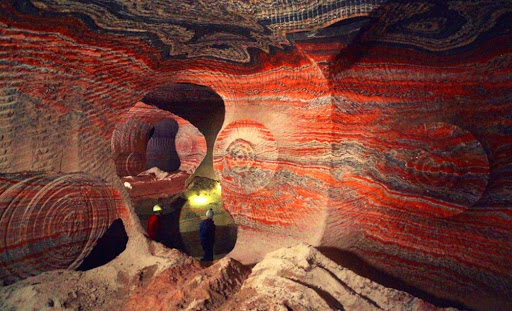by Brenn Robinson
- Introduction
Documentary filmmaking plays a vital role in the creating and spreading of awareness and action to help combat social, political, and global issues. The recent emergence of wide-spread alarm for the earth’s rapidly changing climate has given documentary filmmakers involved with the issue, an opportunity to reach a far broader audience than ever before. Anthropocene: The Human Epoch, directed by Jennifer Baichwal, Nicholas de Pencier, and Edward Burtynsky, is the third film in a trilogy that explores the severe and detrimental impacts that humanity continues to have on the earth and its natural systems and species.
The film Anthropocene: The Human Epoch is based around the research of the Anthropocene Working Group, who declared that “After nine years of research, the evidence shows that we have left the Holocene and entered the Anthropocene Epoch because humans now change the earth and its systems more than all-natural processes combined.” (00:02:09-00:02:30). The urgency of the film’s subject matter demands a call to immediate action. Unfortunately, Anthropocene: The Human Epoch fails to give precedence to the film’s political commentary and instead focuses on the visual beauty of the subject matter.
This essay will argue that the film’s focus on visual beauty is ineffective in addressing the severe social and political issue of climate change. To understand the approach of Anthropocene: The Human Epoch, this essay will first explain how the particular film technologies are less effective for addressing stories on social issues. Secondly, this essay will discuss how the film creates a paradox between visual beauty and political meaning. Finally, this essay will examine the political and cultural implications of the Anthropocene Era within the context climate change movement.

Watch the entire film here: https://www.tvo.org/video/documentaries/anthropocene-the-human-epoch
2. The Effectiveness of Documentary Filmmaking Enacting Change
The first section of this essay will broadly examine the extent to which documentary filmmaking is effective in addressing social issues and enacting behavioural change within its audience members, through the lens of Anthropocene: The Human Epoch. Documentary film media possess the unique ability to convey information both factually and emotionally about social and political issues, regardless of the audience’s prior knowledge or understanding of the topic. As a result, “climate change films may be uniquely situated to encourage engagement. The capacity of film to combine imagery, narrative, and music give it the potential to emotionally engage audiences as well as provide information” (Bieniek-Tobasco 4). Davis Guggenheim’s An Inconvenient Truth is perhaps one of the most successful and influential climate change documentaries of all time. Upon its release, the film directed global attention to the urgency of the climate change movement. The film was of such significance that experts and leaders in various fields promoted its viewership. For example, “the British government strongly recommended that the public watch the film and learn about global warming” (Lin 709). The film went on to earn an academy award for Best Documentary. The success of An Inconvenient Truth is a testament to the effectiveness of documentary filmmaking in the context of the climate change crisis. In contrast, the film Anthropocene: The Human Epoch lacks the same level of effectiveness due to the contradiction between the visuals and the verbal narrative. Despite this flaw, the genre of the film and the fame of its creators allowed the film to reach a larger audience and spread awareness about the current state of the environment. Furthermore, it can be said that “film and media histories are instrumental—empirically and ideologically—for registering this symptomatic awareness of humanity’s discernible impact on the earth’s ecosystems” (Peterson 144). The relationship between documentary filmmaking and the environment gives filmmakers in the genre the ability to uniquely influence society and politics surrounding environmental concerns. However, this ability is paired with the responsibility to document both accurately and effectively the extent of the human impact on the future of the planet.
3. The Paradox Between Visual Beauty and Political Meaning
Edward Burtynsky is one of the directors for Anthropocene: The Human Epoch, and a highly influential Canadian photographer known for capturing industrial landscapes in a surreal and visually beautiful manner. As a result, many of the extremely wide shots within the film bear a strong resemblance to his individual works. Many of Burtynsky’s critics claim that “his aesthetic dilutes his work’s political impact” and argue that “making environmental destruction visually beautiful runs the risk of desensitizing audiences” (Ahlberg 78-92). These critical reviews of Burtynsky’s personal works extend to his influence as a director of the film. The film’s documentation of the Chilean Lithium Mine Production Fields in the Atacama Desert is a strong example of this fault. The fields are introduced by drone footage, capturing an extremely wide shot of the fields which are divided into beautifully coloured blue, turquoise, green, and yellow evaporation pools. Following this, the film shows a series of peaceful shots of workers wading and boating across the stunningly vibrant and colorful surface. This collection of visually beautiful imagery seems to directly contradict the urgent and downcast tone of narrator Alicia Vikander and her message of warning. A similar drone shot of the production fields is repurposed later in the film as a time-lapse, highlighting the shift in colour within the evaporation pools. The visual beauty of these shots overshadows the severe environmental impact of the highly toxic and harmful production fields.
The second example of this fault is evident in the film’s depiction of the Berezniki Potash Mine in the Ural Mountains of Russia. The mines are introduced through panning shots of the tunnels and their beautiful orange and grey patterns revealed by human interference and excavation. The technology employed to produce these panning shots creates a level of smoothness and fluidity that, combined with the beauty of the cave’s colours and patterns, gives the documentation of these mines a quality bordering on surrealism. Visually, the use of these technical shots and methods is greatly appealing to the eye, and easily captures the attention of audience members, however, it inhibits the film’s ability to convey the urgent globally encompassing political message on climate change to its audience effectively.
To summarize, the beautiful visual documentation of the Chilean Lithium Mine Production Fields and the Berezniki Potash Mine, through the use of various camera shots and angles, directly contradicts the film’s narrative and political message.
4. The Political and Cultural Implications of the Anthropocene Era
Anthropocene: The Human Epoch strives to convey a critically important political and global issue but fails to give precedence to the film’s political message over the visual beauty of the composition. At such a critical point in the history of climate change, the ineffective nature of this film significantly lessens the seeming importance of the climate change crisis. This fault is of critical importance as the very existence of climate change is a heavily debated political topic. Therefore, it is vital to examine this film and the message which is hidden beneath multiple layers of pleasing visuals. At its essence, the film addresses and depicts the extent to which humanity has irreversibly altered the earth, its flora and fauna, and many communities’ histories, cultures, and politics. These effects are depicted over the course of seven segments: Anthropocene, Extraction, Terraforming, Technofossils, Anthroturbation, Boundary Limits, Climate Change, and Extinction. Each of these segments explores a new way that these effects manifest themselves in a physical or cultural context. An example of an emotionally engaging and effective segment is Terraforming, which depicts the damages caused by a severe alteration to the earth’s surface in Immerath, Germany. This small German town is the victim of constant demolition and excavation, carried out by some of the world’s largest industrial machines. The film depicts the demolition of the town’s church in an emotionally and politically charged scene, representing how the damage of largescale companies’ activity directly impacts humanity in a physical and cultural manner. The film captures an interview with a local farmer, who reflects on the time of the demolition and how “People actually got together to form a human chain, but none of that changed anything” (00:26:20-00:26:25). This excerpt highlights the destructive and seemingly inhumane methods of extraction that affect the earth and various human communities in irreversible ways. The implications of human activity affect, not only the physical earth but the cultural and political futures of many communities across the globe.
The film continues to establish this correlation between the environmental devastation and politics and culture in its documentation of the mass burning of elephant ivory in Nairobi National Park, Kenya. The Kenyan Wildlife Service and the Kenyan government organized and carried out the burning of the tusks of ten thousand elephants, to signify the official ban of the ivory trade. The burning hut-like structures created by the ivory creates a surreal and iconic image that quickly instigated political action toward an ivory ban in a number of other countries. The film’s documentation of this spectacle can only continue to spread to broader audiences and exact further political change.
In summary, the manner in which the film addresses the cultural and political implications of the Anthropocene Era is ineffective in accurately conveying the severity of the climate change crisis. The German and Kenyan examples provide proof of the direct connection between human activity
5. Conclusion
Anthropocene: The Human Epoch makes strides towards promoting the spreading of knowledge on the climate change crisis but fails to express the severe extent of human environmental impact and the urgent need for immediate action. Instead, the film highlights the visual beauty of these altered, damaged, and desolate landscapes, reflecting the style of Director Edward Burtynsky and weakening the impact of the narrative and the seeming severity of climate change. As opposed to crafting a story focused on producing visually appealing content, documentary filmmakers should focus on constructing their visuals in a manner that supports the film’s narrative. Viewers of Anthropocene should enjoy the breathtaking visuals that the film captures but must also take the time to critically assess the severity of these human processes and activities and their impact on the future of our planet.
Works Cited
Ahlberg, Sofia, et al. “Goodbye Crude World: The Aesthetics of Environmental Catastrophe in Michel Faber’s the Book of Strange New Things and Edward Burtynsky’s Oil Photographs.” The Comparatist, vol. 41, no. 1, 2017, pp. 78-92.
An Inconvenient Truth. Directed by Davis Guggenheim, Paramount Classics, 24 May 2006.
Anthropocene: The Human Epoch. Directed by Jennifer Baichwal, Nicholas de Pencier, and Edward Burtynsky, Telefilm Canada, 13 Sept. 2018.
Bieniek-Tobasco, Ashley, et al. “Communicating Climate Change through Documentary Film: Imagery, Emotion, and Efficacy.” Climatic Change, vol. 154, no. 1, 2019, pp. 1-18.
Lin, Sue-Jen. “Perceived Impact of a Documentary Film: An Investigation of the First-Person Effect and its Implications for Environmental Issues.” Science Communication, vol. 35, no. 6, 2013, pp. 708-733.
Manufactured Landscapes. Directed by Jennifer Baichwal, Zeitgeist Films, 9 Sept. 2006.
Peterson, Jennifer, and Graig Uhlin. “In Focus: Film and Media Studies in the Anthropocene.” JCMS: Journal of Cinema and Media Studies, vol. 58, no. 2, 2019, pp. 142-146.
Watermark. Directed by Jennifer Baichwal and Edward Burtynsky, Mongrel Media, 6 Sept. 2013.
